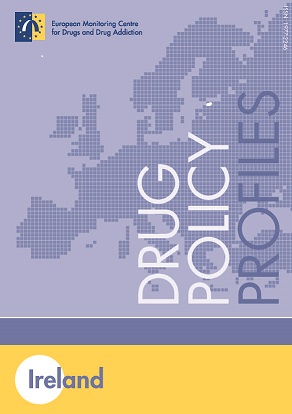Pike, Brigid (2013) Irish and Portuguese drug policies profiled. Drugnet Ireland, Issue 46, Summer 2013, p. 7.
| Preview | Title | Contact |
|---|---|---|
|
PDF (Drugnet Ireland 46)
- Published Version
881kB |

Drug policy in Ireland goes back nearly 150 years. In 1870, when Ireland was still part of the United Kingdom, legislation (the Poisons [Ireland] Act) was introduced to control the sale of various substances, including opium and morphine. Some sixty years later the Dangerous Drugs Act 1934 was passed in order to fulfill Ireland’s obligations under the League of Nations Convention for Limiting the Manufacture and Regulating the Distribution of Narcotic Drugsof 1931. So says a profile of Ireland’s drug policy recently published by the European Monitoring Centre for Drugs and Drug Addiction (EMCDDA).1
In just 20 pages this drug policy profile examines the evolution of Ireland’s drug policy through four historical periods: 1921–1979, 1980–1995, 1996–2008 and 2009–2012. The report explores the country’s national strategies, the legal context within which they have operated, the public funds spent, or committed, to implement them, and the political bodies and mechanisms set up to co-ordinate the responses to the problem. The profile sets this information in context by outlining the size, wealth and economic situation of the country as a whole. Also described is the manner in which events in Ireland resemble, or differ from, developments in other European countries.
Distinctive features of Ireland’s drug policy, according to the profile, are the nature of the drug problem that emerged in the 1980s and the way in which the government responded. The drug problem, which grew rapidly from the early 1980s, was mainly located in poor areas of the capital city and was, at times, linked with violence and public demonstrations. Initially, this led to action at local level which was only endorsed considerably later, in a national policy document published in 1991. The changes that took place after 1996 are attributed partly to the work of the Ministerial Task Force on Measures to Reduce the Demand for Drugs, which recommended the establishment of local drugs task forces, but also to external stimuli. The adoption of the Strategic Management Initiative (i.e. new public management) across government led to the publication in 2001 of a national drugs strategy with clear objectives and the use of indicators. Similarly, the government’s social partnership approach to governing saw stakeholders with different views on the drugs issue involved in implementing the national drugs policy.
In line with its international obligations, Ireland has a ‘balanced’ drugs policy. The profile describes how this ‘balance’ has been achieved:
Consensus among policymakers and other stakeholders on the direction of the action taken in supply reduction appears to have resulted in the development of specialised police forces and new laws to fight organised crime. Drug-demand reduction interventions, however, especially the more controversial harm reduction measures, have often arisen from initiatives at the local level, only becoming endorsed and institutionalised at national level many years later. The achievement of a balance, where supply and demand reduction (including harm reduction) have, at least symbolically, similar weight, took time to develop… . (p. 31)
The profile notes that the public health approach that drove some of the changes in Ireland’s drugs policy in recent decades is now giving rise to the question – how can drug and alcohol policies in Ireland be better linked? Additionally, the development of the ‘legal highs’ phenomenon has triggered new legislative developments, which the profile comments ‘often focus on those who sell these substances and not on those who use them’.
This profile is the second in a series. The first profiled Portugal’s drug policy, which has been under the spotlight since Portugal decriminalised drug use in 2000.2 This policy profile concluded with three observations:
1. The policy reform that occurred in Portugal between 1999 and 2001 was the result of more than two decades of drug policy debate in which there was ongoing tension between the criminalisation of drug use and the desire to help drug users. Over time the debate moved towards a model that prioritises early intervention and treatment over any form of sanction.
2. The decriminalisation of drug use was only one element in a larger policy change that progressively transferred responsibilities from the Ministry of Justice to the Ministry of Health, led to more integrated and detailed plans, highlighted the importance of evaluation as a policy management tool, and brought alcohol and drug policy closer together. These changes have a strong public health orientation and the profile suggests that this might be the best way to characterise Portugal’s drug policy. Rather than representing the Portuguese model as a first step towards the legalisation of drug use or as the new flagship of harm reduction, the model may best be described as a public health policy founded on values such as humanism, pragmatism and participation.
3. Portugal’s drug policy is not proving to be a ‘magic bullet’. The profile notes that the country still has high levels of problem drug use and HIV infection, and does not show specific developments in its drug situation that distinguish it from other European countries that have a different policy. According to the profile, however, Portugal has developed a policy that appears internally consistent and that tries to respond to drug problems in a pragmatic and innovative way.
1. European Monitoring Centre for Drugs and Drug Addiction (2013) Drug policy profiles: Ireland. Luxembourg: Publications Office of the European Union. www.drugsandalcohol.ie/19396
2. European Monitoring Centre for Drugs and Drug Addiction (2011) Drug policy profiles: Portugal. Luxembourg: Publications Office of the European Union. www.emcdda.europa.eu/publications/drug-policy-profiles/portugal
Item Type
Article
Publication Type
Irish-related, Open Access, Article
Drug Type
Substances (not alcohol/tobacco)
Intervention Type
Policy
Issue Title
Issue 46, Summer 2013
Date
July 2013
Page Range
p. 7
Publisher
Health Research Board
Volume
Issue 46, Summer 2013
EndNote
Accession Number
HRB (Electronic Only)
Repository Staff Only: item control page